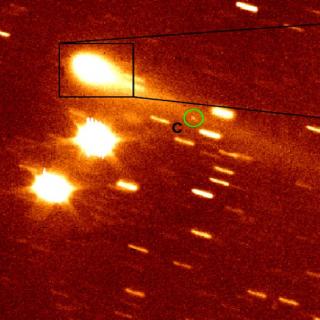Bibcode
Hergenrother, C. W.; Nolan, Michael C.; Binzel, Richard P.; Cloutis, Edward A.; Barucci, Maria Antonietta; Michel, Patrick; Scheeres, Daniel J.; d’Aubigny, Christian Drouet; Lazzaro, Daniela; Pinilla-Alonso, Noemi; Campins, Humberto; Licandro, J.; Clark, Beth E.; Rizk, Bashar; Beshore, Edward C.; Lauretta, Dante S.
Bibliographical reference
Icarus, Volume 226, Issue 1, p. 663-670.
Advertised on:
9
2013
Journal
Citations
60
Refereed citations
56
Description
The NASA OSIRIS-REx mission will retrieve a sample of the carbonaceous
near-Earth Asteroid (101955) Bennu and return it to Earth in 2023.
Photometry in the Eight Color Asteroid Survey (ECAS) filter system and
Johnson–Cousins V and R filters were conducted during the two most
recent apparitions in 2005/2006 and 2011/2012. Lightcurve observations
over the nights of September 14–17, 2005 yielded a synodic
rotation period of 4.2905 ± 0.0065 h, which is consistent with
the results of Nolan et al. (2013). ECAS color measurements made during
the same nights confirm the B-type classification of Clark et al.
(Clark, B.E., Binzel, R.P., Howell, E.S., Cloutis, E.A., Ockert-Bell,
M., Christensen, P., Barucci, M.A., DeMeo, F., Lauretta, D.S., Connolly,
H., Soderberg, A., Hergenrother, C., Lim, L., Emery, J., Mueller, M.
[2011]. Icarus 216, 462–475). A search for the 0.7 μm hydration
feature using the method of Vilas (Vilas, F. [1994]. Icarus 111,
456–467) did not reveal its presence. Photometry was obtained over
a range of phase angles from 15° to 96° between 2005 and 2012.
The resulting phase function slope of 0.040 magnitudes per degree is
consistent with the phase slopes of other low albedo near-Earth
asteroids (Belskaya, I.N., Shevchenko, V.G. [2000]. Icarus 147,
94–105).
Related projects

Minor Bodies of the Solar System
This project studies the physical and compositional properties of the so-called minor bodies of the Solar System, that includes asteroids, icy objects, and comets. Of special interest are the trans-neptunian objects (TNOs), including those considered the most distant objects detected so far (Extreme-TNOs or ETNOs); the comets and the comet-asteroid
Julia de
León Cruz